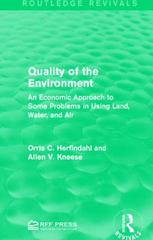Question
Solve this problem using a diagrammatic approach. Consider a variant of the static GE model in which the representative household has preferences given by U(C,
Solve this problem using a diagrammatic approach.
Consider a variant of the static GE model in which the representative household has preferences given by U(C, l), where U(.) is a standard quasi-concave utility function. The representative firm's production function, F(K, Nd), is a standard concave production function. Suppose that the capital input is fixed at K. The government subsidizes employment. It does this by paying firms a subsidy s for each unit of labour employed. The government finances this subsidy by taxing households using a lump sum tax. The government balances its budget. The subsidy rate is s > 0, and the lump sum tax is given by T. Treat the subsidy rate as an exogenous variable and the tax as endogenous.
(i) Formally dene a competitive equilibrium in this economy.
(ii) Write down the household's optimization problem. Depict the solution to the household's problem in a diagram.
(iii) Write down the firm's profit maximization problem. Depict the solution to the household's problem in a diagram.
(iv) Depict the competitive equilibrium in a diagram
(v) Show that your diagram in part (iv) satisfies your definition in part (i).
(vi) Show whether the equilibrium in part (iv) is or is not Pareto efficient. Explain.
 1. Solve this problem using a diagrammatic approach. Consider a variant of the static GE model in which the representative household has preferences given by U(C, l), where U(.) is a standard quasi-concave utility func- tion. The representative firm's production function, F(K, No), is a standard concave production function. Suppose that the capital input is fixed at K. The government subsidizes employment. It does this by paying firms a subsidy s for each unit of labour employed. The government finances this subsidy by taxing households using a lump sum tax. The government balances its budget. The subsidy rate is s > 0, and the lump sum tax is given by T. Treat the subsidy rate as an exogenous variable and the tax as endogenous. (i) Formally define a competitive equilibrium in this economy. 3 points] (ii) Write down the household's optimization problem. Depict the solution to the household's problem in a diagram. [3 points] (iii) Write down the firm's profit maximization problem. Depict the solution to the firm's problem in a diagram. [3 points] (iv) Depict the competitive equilibrium in a diagram. [3 points] (v) Show that your diagram in part (iv) satisfies your definition in part (i). [3 points] (vi) Show whether the equilibrium in part (iv) is or is not Pareto efficient. Explain. [3 points]
1. Solve this problem using a diagrammatic approach. Consider a variant of the static GE model in which the representative household has preferences given by U(C, l), where U(.) is a standard quasi-concave utility func- tion. The representative firm's production function, F(K, No), is a standard concave production function. Suppose that the capital input is fixed at K. The government subsidizes employment. It does this by paying firms a subsidy s for each unit of labour employed. The government finances this subsidy by taxing households using a lump sum tax. The government balances its budget. The subsidy rate is s > 0, and the lump sum tax is given by T. Treat the subsidy rate as an exogenous variable and the tax as endogenous. (i) Formally define a competitive equilibrium in this economy. 3 points] (ii) Write down the household's optimization problem. Depict the solution to the household's problem in a diagram. [3 points] (iii) Write down the firm's profit maximization problem. Depict the solution to the firm's problem in a diagram. [3 points] (iv) Depict the competitive equilibrium in a diagram. [3 points] (v) Show that your diagram in part (iv) satisfies your definition in part (i). [3 points] (vi) Show whether the equilibrium in part (iv) is or is not Pareto efficient. Explain. [3 points] Step by Step Solution
There are 3 Steps involved in it
Step: 1

Get Instant Access to Expert-Tailored Solutions
See step-by-step solutions with expert insights and AI powered tools for academic success
Step: 2

Step: 3

Ace Your Homework with AI
Get the answers you need in no time with our AI-driven, step-by-step assistance
Get Started


